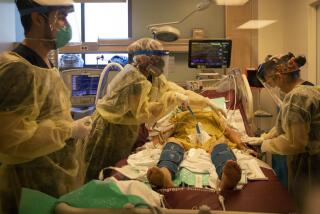MANY FACES, ONE HEARTACHE
- Share via
He was older than we expected. But not really older, because that’s the way of war. Given the era in which he served, “he” was a “she” sometimes. Lacquered in grimy coats of sand and sweat and dust and sometimes tears of pain, he wore a rainbow of skin colors. Not that it mattered a whit. Through the din of shellfire, the clatter of war’s machinery and the scream of battle, he spoke with many accents. This didn’t matter either, except to tell of the culture of his homeland. He was a full-timer, and he was a part-timer too. Driven by hope, driven by duty, driven by both, he volunteered for this, yes.
But he didn’t volunteer for this. And now he is gone.
A thousand times over, one by agonizing one, or sometimes together as parts of a group, his life was cut short in the cause of his country.
On Tuesday, Sept. 7, homeland time, American fatalities in Iraq reached a milestone of 1,000 -- 997 uniformed troops and three civilian employees of the Department of Defense, the White House said. Associated Press, using informal as well as official sources, reported early today that the toll had risen to 1,003.
In mythical America, that’s equivalent to an entire heartland farming town. Or the student body of a big-city high school.
In the real-life of the country, the toll has meant loss from coast to coast and beyond to distant territories at the rate of 13 dead each week for nearly 18 months now.
California’s loss has been greatest, 118 and counting.
Because the names and circumstances of the most recent casualties have not been released, the portrait of American war deaths accounts for 983 of the 1,003.
Of these, 24 were women. An Associated Press analysis and its “War Casualty Database” list 711 combat deaths. The rest resulted from accidents, friendly fire, illness or suicide.
The oldest was 59 and the youngest 18, too young to legally consume a beer in many states. More than half were felled before they reached the age of 30.
All but 138 deaths occurred after May 1, 2003, when President Bush stood under a banner that declared “mission accomplished.” He announced an end to major combat operations in Iraq.
Tuesday’s casualty count included one soldier killed in a rocket-propelled-grenade attack in Baghdad’s Sadr City, a military police officer shot to death in western Baghdad, a soldier who died in an attack in eastern Baghdad and yet another who died of wounds sustained during a bombing the night before.
On Monday, seven Marines were killed in a car bomb attack near Fallouja and three soldiers died in other scattered attacks.
In the half-century-plus since World War II, America’s armed conflicts have been, like this one, controversial. But not, for the most part, the nation’s reverence for its battlefield deaths. The fallen continue to be honored by the long-lasting echo of Winston Churchill: “ ‘Not in vain’ may be the pride of those who have survived and the epitaph of those who fell.”
“My heart is broken every time I hear another family is going to have to face what we’ve faced,” said De’on Miller of Lovington, N.M. Her son, Marine Lance Cpl. Aaron Austin, was killed in April. “I just hope that they’re as proud of their son’s service as we were for Aaron.”
Asked what advice she could offer families who will next endure the dreaded knock on the front door from the military’s casualty notification teams, Miller replied, “Find comfort in each other and your faith and the fact that the world is with you. These times really hurt, but you’re not alone.”
Families aren’t the only ones shaken by the rising casualty numbers.
“We’re losing so many boys. It isn’t only one Marine that’s killed -- it affects a whole family. Even my neighbors were affected,” said Liz Ceniceros, a resident of East Los Angeles and the widow of Marine Corps Lance Cpl. Manuel Ceniceros, who was killed in hostile action June 26.
“I understand why we went over there. I’m torn between the love of my husband and the honor of being an American,” she said. “By all means, whatever it takes to protect our country and our freedom. But if we’re going to lose so many men and women, maybe we ought to step back and take a harder look at this.”
Eric Blickenstaff, of Portland, Ore., said the time for looking had passed. His younger brother, Army Spc. Joseph M. Blickenstaff, drowned in December when his Stryker armored vehicle tumbled into an irrigation canal. Eric has since joined the antiwar group Military Families Speak Out.
“I think up until now people have tried to ignore the death toll,” Blickenstaff said. “I don’t think people really want to know. They don’t want to know what the true cost of this war is.... They will tell you that your relative died for a good cause, but I think they say that to make themselves feel good. They don’t want to feel like they were deceived.”
America’s modern military beckons volunteers for a host of reasons, from patriotism to job training. For a few, there is another motive.
So far in this war, at least 10 immigrants died fighting under the flag of the United States in the quest for citizenship, according to AP’s database analysis.
From here in the Western part of the nation, 21 of the dead came from Oregon, three from Nevada, four from Wyoming, eight from Idaho, five from Utah, 20 from Washington state, four from New Mexico, 14 from Colorado, four from Montana. Texas has lost 84 men and women, second only to California. The Marianas Protectorate reported the loss of one resident. Though not complete, the tally shows that every state in the union has been touched by deaths except Alaska.
Roughly 7,000 others have been wounded, some left forever disabled.
U.S. coalition partners have lost 125 people, just more than half of them British.
About 18% of the Americans killed were part-timers in the military, 110 from the National Guard and 74 reservists. By branch of service, the Army has lost 715 troops; the Marines, 234; the Navy, 21; the Air Force, 12; and the Coast Guard, one.
Beyond the borders of Iraq, the U.S. military has reported 135 deaths in Afghanistan, Pakistan, the Philippines and elsewhere as a result of post-Sept. 11 operations.
Of the U.S. casualties in Iraq, information on racial demographics is current only through mid-August, but shows this: 655 of those who died were white, 122 were black, 113 were Hispanic or Latino, 22 were Asian, 10 were American Indian and eight were Native Hawaiian or Pacific Islander. Among the dead were the first Native American woman killed in combat in the uniform of the U.S. military and a Sioux who traced his ancestry to chiefs Crazy Horse and Sitting Bull.
The names to be enshrined in some war memorial of the future begin with Genaro Acosta, of Fair Oaks, Calif., and continue through the alphabet to Andrew Zabierek, of Chelmsford, Mass. In between, one can read the roll call of contemporary America: Rasheed Sahib, of New York City; Juan Lopez, of Whitfield, Ga.; Christopher J. Holland, of Brunswick, Ga.; Nichole M. Frye, of Lena, Wis.
For those who have been on hand in the deserts and cities and mountains of Iraq in the days since the March 20, 2003, invasion, these deaths were both predictable -- the military makes estimates of potential casualties in its operations -- and startling, because they did not let themselves believe it would be them.
In the aftermath, buddies recall what turn out to be last conversations. They look at an empty seat in a Humvee where their friends always rode. For a while anyway, the empty spaces are almost palpable enough to see. At headquarters, a wax pencil adds a number to an acetate chart. Chances are that by the time a wife or a husband, children, brothers and sisters and father and mother can react, the remains are already en route out of the war zone.
Back home, families are left to cope with both the agony of their loss and the cutting cross-currents of an uncertain nation’s politics.
Jeff Reed, a deputy sheriff in Tracy, Calif., lost his nephew Army Pfc. Jesse Jack Martinez in a vehicle rollover July 14. “My nephew was over there for what he believed were the right reasons.... He believed that he would make a difference if we would deal with the insurgencies now rather than later.”
With equal resolve, Celeste Lawrence of Tucson argued, “My husband died so our country could be safe. Every one of the 1,000 died for that reason.” Lawrence gave birth to a daughter, Cadence Freedom, just days after the July death of her spouse, Marine Cpl. Jeffrey Lawrence.
Not everyone endures their suffering with such certainty of mind.
“I just don’t know what to think. Part of me wants to support the war, but part of me doesn’t,” said Elena Zurheide of Camp Pendleton. She too gave birth to a child, a son, Robert Paul, days after losing her husband, Lance Cpl. Robert Zurheide, in April. “My whole view changed when my husband died.”
And for some, there’s anger. “Most Americans are in a stupor and they’re not following this [body count]. They’ll feel different though when it’s their own child,” said Jane Bright of West Hills. Her son, Army Sgt. Evan Ashcraft, died in July in an ambush in northern Iraq.
“Unless you’ve lost a child there’s no way to understand what it’s like,” she continued. “ ... Not only is there this terrible void and emptiness, and this pain I see in my other son’s eyes -- there’s also this misrepresentation and obfuscation of the war happening at the same time. It’s incredibly painful. I don’t have words in my vocabulary to describe it.”
For many Americans, the growing casualty count is a matter of foreboding.
Angela Talley, 21, was in tears Tuesday. Her husband, Marine Lance Cpl. William Talley, leaves Camp Pendleton next week for duty in Iraq.
“It’s not good,” she sobbed. “Our son is only 11 days old. It’s all very frightening.”
*
Times staff writers Tony Perry, Wendy Thermos and Monte Morin contributed to this report.
*
(BEGIN TEXT OF INFOBOX)
The fallen
According to Associated Press, more than 80% of U.S. military deaths in Iraq were among active-duty military, with the rest in National Guard and Reserve units. AP is reporting a total of 1,003 dead -- 1,000 service members and three military civilians. Of these, 845 deaths have occurred since the end of major combat was declared May 1.
Number of deaths*
By branch of service
Army: 715
Marines: 234
Navy: 21
Air Force: 12
Coast Guard: 1
By age group
18-25: 566
26-35: 292
36-45: 109
46-55: 15
56+: 1
States hit hardest
California: 118
Texas: 84
Pennsylvania: 52
Florida: 44
Illinois: 39
Combat/accident
Combat: 711
Accident**: 150
Noncombat**: 74
Helicopter: 25
Other/unknown: 9
Illness: 7
Friendly fire: 4
Race/ethnicity (as of Aug. 14)
White: 655
Black or African American: 122
Hispanic or Latino: 113
Asian: 22
American Indian or Alaska native: 10
Native Hawaiian or Pacific Islander: 8
Multiple races, pending, or unknown: 7
*Figures are based on AP’s database analysis of 983 dead, which includes only those who have been named. The actual total number of dead is higher.
**Noncombat includes suicides, heart attacks, heatstrokes, etc; accidents usually involve vehicles. Both categories include accidental discharge of weapons.
Sources: Associated Press, Department of Defense
More to Read
Sign up for Essential California
The most important California stories and recommendations in your inbox every morning.
You may occasionally receive promotional content from the Los Angeles Times.










